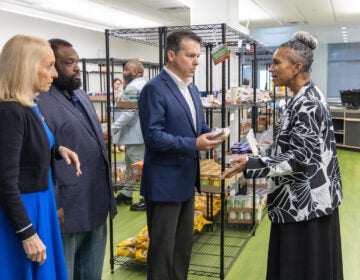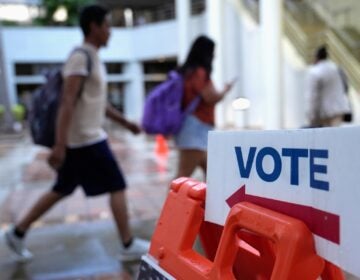Thoughts from a Tucson parking lot
It’s a strip shopping center, just like thousands – no, make that tens of thousands – across America.
A Walgreens anchors one corner. There’s the obligatory “mall Chinese” eatery, with the booths upholstered in red. A chain haircut joint. Diagonally across the lot from Walgreens, a Honey-Baked Ham store.
And it has a supermarket. A Safeway.
Three weeks ago, the sidewalk in front of this particular Safeway became the focal point of all America, a vortex of pain, grief, heroism, recrimination and, eventually, a slow-dawning hope.
Hope that the awful moment on Jan. 8 when Jared Lee Loughner pulled out his automatic weapon might somehow become a pivot point of our history.
Hope that it might prove, in retrospect, to be the watershed instant when we turned away from the abyss, recognized the merchants of venom for who they are, vowed to nurture the ties that bind us, not the fears that rip us apart.
Hope now blossoms all over that sidewalk, under the alcove where Gabby Giffords was standing, chatting with voters, as the gunfire burst out. It comes in the form of bouquets, Mylar balloons, the crayoned scrawls of school children, the earnest statements of groups with names like Tucsonans for Civility.
A new spot for pilgrims
This week, I’m in the wounded but resilient city of Tucson. This visit with wonderful old friends was planned long before the Safeway shootings. And we’ve done some of the typical things visitors to Pima County do – the gorgeous walk up Sabino Canyon, a dinner of “authentic” Mexican.
But there are several new spots on the rota of must-see Tucson locales: this Safeway in this ordinary strip mall – along with a nondescript two-story office building on another busy corner in the shadow of the Catalina Mountains. That one has a sign in front saying: “Office of Congresswoman Gabrielle Giffords.” There, you see even more of the bouquets, balloons, banners, and poems on posterboard, sweeping in a 60-foot arc around the corner.
Last night, I stood at the Safeway, reading the second-graders’ notes with their heartbreaking hopefulness and misspellings, the touching handwritten notes telling of Giffords’ acts of kindness. (Make no mistake: This person who now fights for life in a Texas hospital was much loved in this city even before she was shot.)
My eyes welled up; I’m like John Boehner that way, cry at the drop of a hat.
What hit me hard, standing there, is what I think hit a lot of people when they got word of the horror. A Safeway. How ordinary, workaday, routine. When the developer bought the tract, did the site plan, reviewed the architect’s dull drawings, hired the bulldozers, and bought the colored pennants for the Grand Opening, he never once thought he was building a place whose name would echo through American history. He thought he was building a place where people would spend and make money, in the usual, routine ways.
We’re a big land full of such cookie-cutter spaces, America. So our history – especially its most painful episode – tends to get made in such ordinary spots: a wheat field in Gettysburg, a grubby motel in Memphis, a book storage building in Dallas, a hotel kitchen in Los Angeles.
Clinging to a sense of sacred
So what are all those flowers, now slightly wilted, all those balloons, now deflating, all those posters, now fraying at the edges, trying to do on that sidewalk in front of the Safeway?
In part, to claim this space as special, sacred – to insist that it resist the potent pull of the ordinary, that it fight the temptation to lapse back into the workaday.
How can we let this strip mall return to being just another place that people come to get their hair cut or to stock up on Tostitos?
Yet that, in all likelihood, is what will happen. All said and done, we’re not big, we Americans, on reminders that jostle us out of comfort zones. And we do like our Tostitos.
I walked inside the Safeway – a store whose management has behaved, my Tucson friends tell me, in exemplary fashion since the shootings.
Pistachio nuts were on sale. Next to that display was a display bin selling movie DVDS for the low, low price of $5.95. (Netflix, what ye have wrought.)
I glanced at the titles. Apocalypse 10.5. The Gangters’ Gallery collection. A number of other slasher and shoot ’em-up titles. Not 30 feet from where Gabby Giffords stood on that sunny Saturday morning, the Safeway that is now part of history, the store whose managers have generally shown sensitivity and class in the face of challenge, still numbly offers for sale movie titles that both reflect and fuel our nation’s culture of routine violence.
That’s the real challenge to us in the wake of the Safeway shootings. Not just to light a candle, mumble a prayer, or sign a petition.
But to confront the plain fact that, in our culture, violence is every bit as ordinary as a Safeway on a sunny morning.
Jared Lee Loughner, weird and deranged as he is, is a type that our nation summons forth with sickening regularity.
He is not so much an anomaly as a piece of a pattern. And a warning.
After the flowers and bouquets and posters get carted away, when the scrubbed sidewalk in front of the Safeway’s sliding doors is bare and unremarkable again, will we have the wisdom and the will to heed that warning?
That’s the prayer that I would add to all the heartfelt ones spread across that sidewalk: That we never forget how we felt that day when we heard the news from Safeway. That we can be willing to change, to take risks, to sacrifice biases and abandon old reflexes, so that such horror never stains a sunny Saturday again.
Lord, grant us that this Safeway, in this ordinary little shopping complex, never slips from our memory again.
WHYY is your source for fact-based, in-depth journalism and information. As a nonprofit organization, we rely on financial support from readers like you. Please give today.




